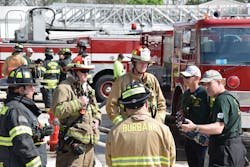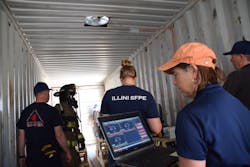Where does higher education fit into the fire service? There’s no one-size-fits-all answer, and it also is important not to look at education as replacing things, such as experience, training and maintaining competency. It takes all of those fire service learning ecosystem components to have a balanced fire service mindset.
Numerous courses that I took during my fire service career supplemented, structured or affected my reasoning and leadership. I put these courses and experiences into three categories: general education, organizational development, and research methods and application.
General education
In the general education category, four courses that I took as part of my master’s program have had a positive effect on my career as a firefighter and training officer and in my role at the Illinois Fire Service Institute.
The greatest effect came from courses on instructional design. These courses help me to understand how to best capture and share information in a program. Think of an Instructor 1, Instructor 2 or Instructor 3 course on steroids, with a broader slate of methods and more time spent creating curriculum or training and less use of off-the-shelf products. Instructional design is the equivalent of your strategy for teaching, and it’s foundational for learning to not only occur as a result of teaching but for that learning to be meaningful and for it to transfer effectively from the classroom into our fire service practice.
Two courses that I took in pursuit of my education degree deeply affected my ability to teach and train others: adult learning and educational psychology. These focused less on the content of the presentation and more on the different methods to apply for students. Understanding the learner’s motivations, understanding how the human mind accepts, absorbs, encodes and recalls information and understanding how to make a concept “stick” all flow from these two topics. Coupled with instructional design methods that are aimed at presenting information in a logical and cumulative way, knowing how adults learn and how they retain information has been pivotal in my ability to design processes to produce more effective learning.
The last course of general education topics that I found important to understand in my role as a training officer is how to apply different methods of presenting information to best suit the audience. At no other point in our careers have there been so many different methods to reach learners. We all carry a “computer” in our pocket, with access to millions of hours of training. How is your department using technology to meet your firefighters where they are with training, education, information and research?
To engage with the significant number of younger firefighters, there’s an opportunity to tailor educational delivery methods to meet their learning styles while not compromising the quality of content.
Human resource development (HRD) is an emerging field and still is defining its scope of practice and what is a part of the profession. The field of HRD takes a broader view of what we tend to narrowly construe as training in the fire service.
Three noteworthy courses in this category that transfer well from the corporate education world into the fire service are organizational development, strategic HRD, and technology transfer and innovation.
Organizational development (OD) focuses on identifying where an organization currently exists, where it wants to be and how to close the gap between the two.
Strategic HRD is an important peer to the OD concept. OD looks at how to structure the organization. HRD involves helping your people to provide the level of service that’s desired for your customers and the community. OD is the how, and strategic HRD is the who that makes the “how” happen.
In regard to technology transfer and the implementation of innovation, the fire service sometimes is described as “hundreds of years of tradition unimpeded by progress.” Still, the reality is that we tend to embrace technology that helps us to do our jobs better. We just don’t tend to apply technology strategically and consistently in training programs and the delivery of services. We carry thermal imaging cameras; we wear new aramid fibers; we perform post-fire skin decontamination. Our challenge is that we don’t have a consistent, unified voice or understanding of how emerging technologies can help us to serve our constituents more effectively.
We must be more thoughtful about the opportunities to grow and improve safe delivery of our services. This includes tech for monitoring firefighter vital signs during suppression, adding virtual and augmented reality to training and certification, incorporating sensors that are in buildings into response planning and leveraging unmanned aerial systems for responses.
Research
The final area—and perhaps the most impactful in my experience—has been understanding how to plan, conduct, read, understand and apply research.
Without disparaging people who use an internet search engine to answer a question or to satisfy their curiosity, there are many more layers to research than this. Those layers and nuances help you to find the best, most comprehensive answer.
Key learnings for me in the area of research include an approach of disciplined inquiry: how to craft a good research question, understand what already exists in the literature and profession on a particular topic, and detect spin and bias when conducting and applying research. We can’t seek just answers that support our view. We must think critically and reconcile our understanding with information that might be contrary to our view and to what we believed to be true in the past.
Two major fields of inquiry that are based on the methods that are being employed currently are qualitative methods and quantitative methods.
Quantitative methods are those that can enumerate objectively a phenomenon or situation. Temperatures of a compartment during a fire, levels of carcinogenic particles in a burning room and performance of test questions all fall into the areas of quantitative analysis.
Qualitative methods are less directly measured. They can include asking questions about attitudes toward an issue and understanding phenomenon in greater depth than mere numbers can describe.
It’s common to combine both qualitative and quantitative methods into what is called mixed-methods research. Understanding how data were collected and how conclusions were reached is important in applying the conclusions of research to an individual’s practice.
Persons who are pursuing research degrees must be able to critically apply research and ensure that the right studies are applied to a problem at hand. Research methods courses that are available in the academic realm help to create an understanding of how a study was structured and conducted, so the end user can understand where the data that derives from the study can be applied as well as where they shouldn’t be applied. Although it isn’t accurate that any solution can be applied to any problem, it’s equally untrue that every emergency is so unique and different that we can’t generalize and learn from others.
Development and growth
Again, education, in general, and higher education, in particular, in the fire and emergency services aren’t one-size-fits-all solutions. For my role as an executive at a state fire academy, I was able to tailor my programs of study (educational policy and organizational leadership) to fit my career path. For others, a program in public administration, healthcare leadership or crisis management might be a better fit. For many roles, a certificate program might offer a better course of professional development. Whatever path that you choose, learn! There’s no downside to professional development and growth.
About the Author
Brian Brauer
Dr. Brian Brauer is the associate director for infrastructure and special projects at the University of Illinois Fire Service Institute (IFSI). He joined the IFSI field staff in 1998. Brauer has volunteered as a fire officer and EMT since 1990. He is the chairman of the committee on accreditation and sits on the board of directors of the Pro Board Fire Service Professional Qualifications System. Brauer is active with the North American Fire Training Directors and is a registered nurse. In each of these roles, he leverages his formal education to implement sustained organizational change. Brauer earned a bachelor’s degree in nursing from the University of Illinois at Chicago (UIC), a master’s degree in global human resource education from the University of Illinois, and a doctorate in policy and organizational leadership from UIC. Since February 2020, hehas served as an emergency operations center manager for the University of Illinois and Champaign County response to the COVID-19 pandemic.

